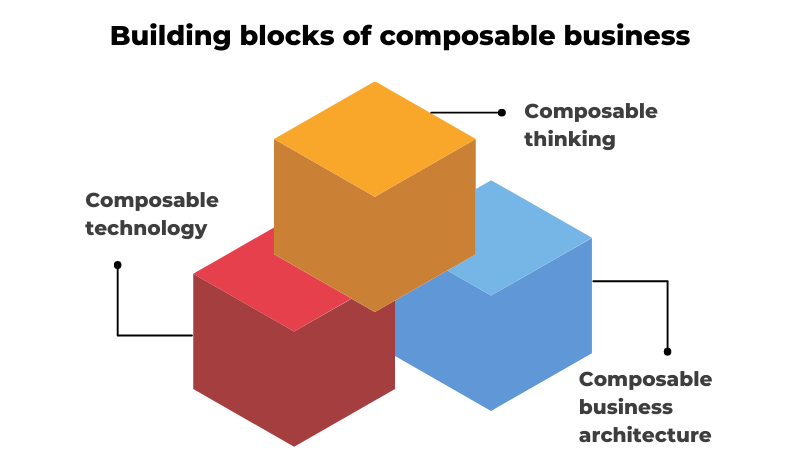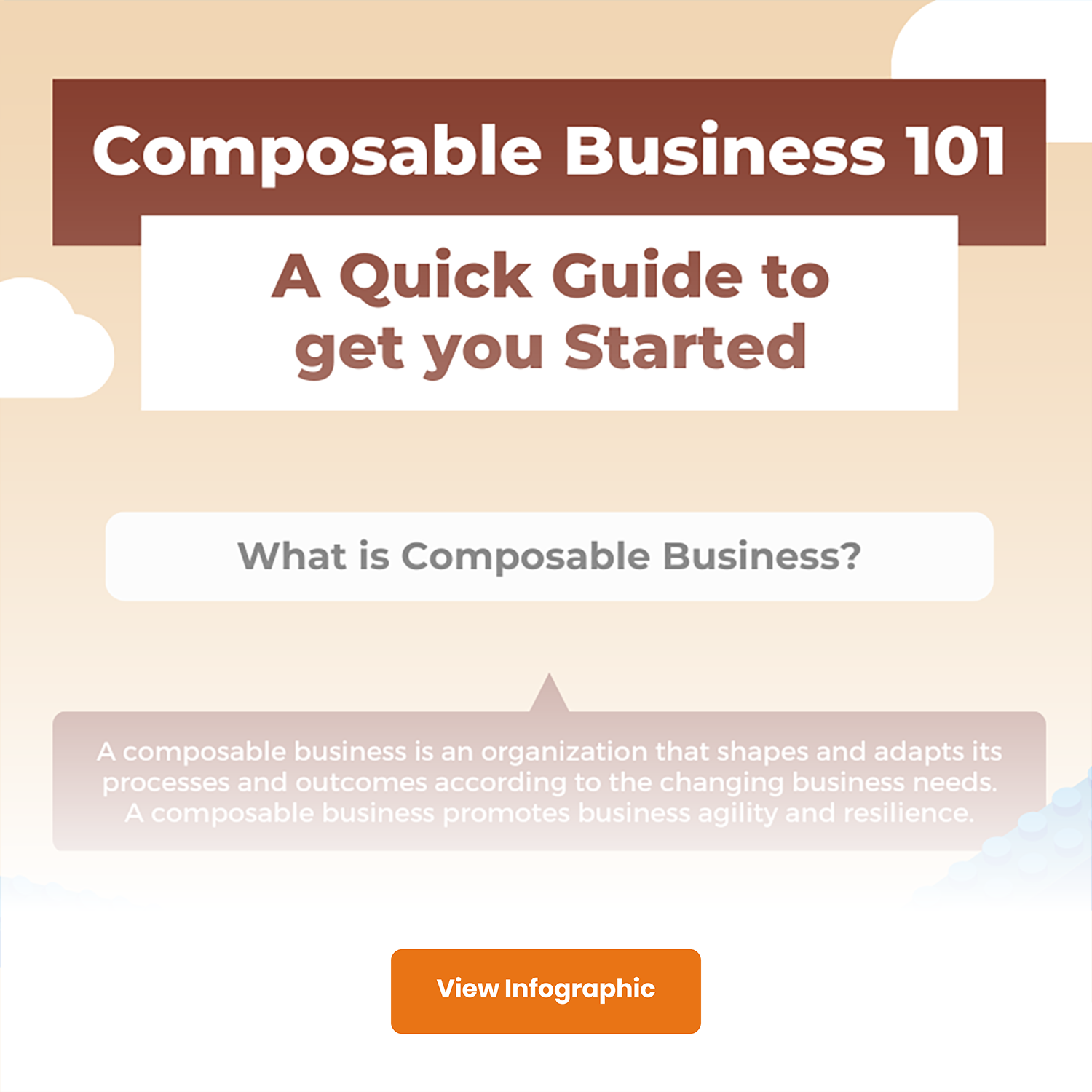
In times of disruption, businesses can either drive change or get outsmarted by their peers. Visionary leaders need to challenge business conventions and use this day and age of digital disruption to reinvent or reimagine their business models. This reinvention or reimagination can form the strategic, cultural foundation for many decisions that lie ahead.
Enters composable business!
“Composability” is a term that encompasses mindset, technology, and processes that enable organizations to innovate and adapt rapidly to changing business needs.
What is a Composable Business?
A composable business can be imagined as Lego blocks that can be arranged, rearranged, and discarded as necessary. It enables businesses to tear down bulky, legacy applications into distinct components that can be designed, scaled and maintained independently. In comparison, consider an inflexible, monolithic organization that is slow to evolve and difficult to change (like cinderblock). Composable businesses can respond quickly to market shifts by assembling and disassembling various components.
“Composable business is a natural acceleration of the digital business that you live in every day. It allows us to deliver the resilience and agility that these interesting times demand,” said Daryl Plummer, Distinguished VP Analyst, Gartner.
In turbulent times, businesses that are prepared for digital disruption hold a strategic advantage over their competitors. Being composable is integral to this preparation and it makes enterprises adapt to disruption easily, quickly, securely, and cost-effectively. The leaders in the industries where change is most urgent, like commerce, manufacturing, and healthcare, are already practicing it.
Throughout history, great leaders have faced turmoil and turned it into inspiration,” said Don Scheibenreif, Distinguished VP Analyst, Gartner. “Composing: being flexible, fluid, continuous, even improvisational — is how we will move forward.
The three building blocks of composable business
Composable thinking, composable business architecture, and composable technology are the three pillars of composable digital business.

1. Composable thinking
It encourages the idea that “anything is composable”. Composable thinking enables a more flexible, responsive way to address rapidly changing customer needs. It emphasizes sharing and seeking information inside and outside the organization. For example – garnering ideas from your employees to improve CX or registering customer experiences from different industries and situations. When the principles of modularity, autonomy, orchestration, and discovery are combined with composable thinking, enterprises can be guided regarding what to compose, and when.
2. Composable business architecture
It ensures flexibility and resiliency for your organization. It encompasses structural capabilities that provide enterprises with mechanisms to architect their business.
Considerations when using composable business architecture include:
- There are three dimensions in the composable business architecture, namely engagement, technology, and capability.
- Composable business architecture is an addition and not a replacement for your current business architecture. It is a lens that assists you in identifying and implementing the changes necessary to capitalize on the benefits of digital acceleration and serves as a guide for implementing these changes through technology investment decisions and business initiatives.
- It is not a business model but rather assists enterprises in preparing a model that supports digital acceleration.
- It is not an organizational structure but can enable the formation of organizations and teams on an ad hoc basis.
- The different elements of the composable business architecture can be incrementally applied to your current business architecture based on your industry. It is neither necessary nor recommended to do it all at once.
3. Composable technology
It is about providing agility and flexibility. It encourages reusability, augmented connectivity, and transparency across the enterprise. You can leverage composable technologies, including no-code platforms like Quixy, data mesh, and traditional BI/advanced analytics platforms to offer guidance and flexibility to improve the B2B customer experience.
Also read: Understanding Digital Transformation and the way forward
The Journey to composable business
The journey to composable business begins with leaders and decision-makers embracing a new way of thinking:
- A thinking that sees change as an essentiality and not as a risk or burden to achieve big and small outcomes.
- A thinking that sees non-changeable entities as technical debt and a barrier to the vitality of the organization that’s facing turbulence and uncertainty.
- A thinking that encourages proactiveness and anticipation rather than knee-jerk reactions regarding change among business leaders.
- A thinking that brings stability and agility emerges through composability.
Also Read: 2022 CIO Agenda: Create an Action Plan to Master Business Composability
Two big reasons for business leaders to adopt composability
1. Missing a business opportunity
Some leaders may have missed out on a business opportunity due to their inability to make the necessary changes. Or they have been unable to adapt quickly enough to a business or cybersecurity event that has disrupted their operations. They may have already encountered these situations or are anticipating them. Acquiring the ability to change more quickly and safely is an effective defense against disruption, and composability is the means to that end.
2. Desire to create new business opportunities
Some leaders are natural risk-takers and don’t wait for opportunities. Instead, they go all out to create opportunities. They leverage modularity to mitigate the increased risks of strategic change.
The core design principles of composability
Digitized processes are facing difficulties in keeping up with rapidly generating business ideas. Composable businesses enable executives to plan more substantial business changes frequently and to keep a closer eye on changing consumer needs. Organizations across industries can apply the following design concepts of composability to their business models, corporate business operations, and strategy.
- More speed through discovery
- Greater agility through modularity
- Better leadership through orchestration
- Resilience through autonomy

Why to prioritize composability into your application architecture
Although modularity is a familiar concept for application architects, the rise of citizen developers (democratization of technology) and fusion teams has thrown up new opportunities, requirements, and challenges.
This democratization of technology delivery requires new processes (application development using no-code platforms). The focus on business-IT fusion teams shifts application modularity from technical APIs to business capabilities (and API products). This is where composable architecture can help organizations distribute responsibilities in a way that organically collaborates with business units and IT teams.
- Creators implement composable modularity by encapsulating business capabilities into packaged software building blocks and registering them in the central catalog/marketplace. These are often application providers or internal IT teams using professional software engineering tools or advanced low-code or no-code tools.
- Curators can manage the catalog/marketplace by implementing policies and standards to ensure quality and integrity for the composition process.
- Composers (Citizen developers) can build composable applications (automating processes) with no-code platforms like Quixy.
- Consumers can use the no-code applications to pursue their business objectives and make some minor customizations.

Conclusion
CxOs should look for the “moments of composability” and seize the opportunity they present. A change in the consumer attitude (societal), a pandemic like COVID-19, or a global recession (geopolitical) can all come under the bracket of these moments. When encountering such adversities or opportunities, business leaders must either recognize the need for an immediate change in the organization or risk having the business falter or fail.
Frequently Asked Questions(FAQs)
Q. What is a composable business?
A composable business is an agile and flexible organization that builds and adapts its processes, services, and resources like building blocks, enabling rapid responses to changing market needs.
Q. What is an example of a composable business?
An example of a composable business is an e-commerce platform that easily integrates with various payment gateways, shipping providers, and third-party apps to customize its offerings based on customer demands.
Q. What are the 4 principles of composable business?
The 4 principles of composable business are modularity, autonomy, discoverability, and reusability. These guide the design and implementation of flexible and interoperable business components.
Q. What is a composable technology?
Composable technology refers to software or systems designed to be modular and easily integrated with other technologies, allowing businesses to build custom solutions tailored to their unique requirements.
Q. What is composable strategy?
Composable strategy is a dynamic approach that focuses on assembling and rearranging various business capabilities to respond quickly to market changes, seize new opportunities, and optimize performance.
Login
Please login to comment
0 Comments
Oldest
















